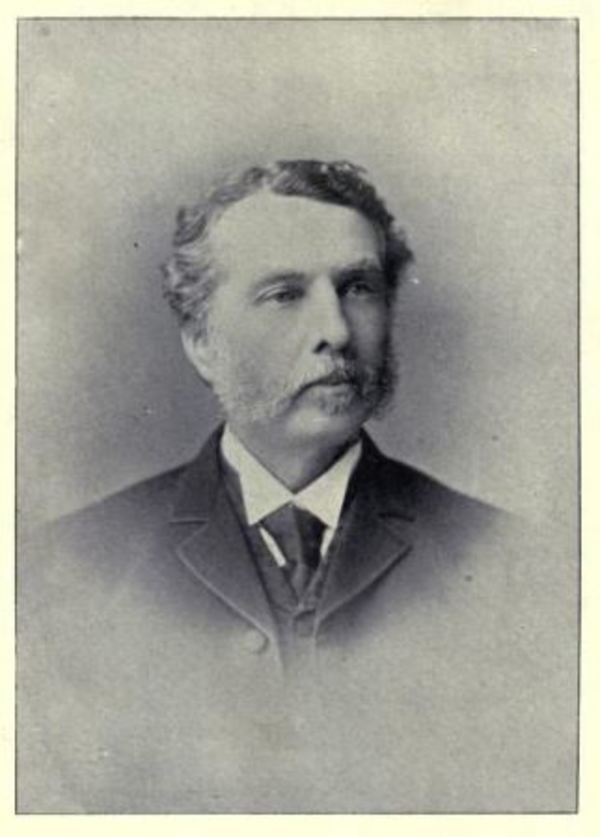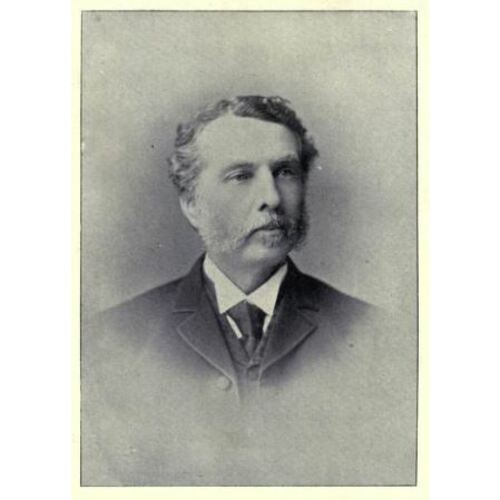
Source: Link
BOYD, Sir JOHN ALEXANDER, lawyer and judge; b. 23 April 1837 in Toronto, only child of John Boyd and Margaret MacCallum; m. there 31 Aug. 1863 Elizabeth Buchan, and they had nine sons and three daughters; d. there 23 Nov. 1916.
John A. Boyd achieved scholastic honours throughout his education in Toronto, at the Bay Street Academy (founded by his Scottish father), at Upper Canada College (from which he graduated in 1856), and at the University of Toronto (ba 1860,
Boyd’s long legal career began in 1860, when he was articled to David Breakenridge Read*. He attended Osgoode Hall and was called to the bar in 1863. Until 1870 he practised with Read; he then moved to the firm of Blake, Kerr, and Bethune. Between October 1870 and November 1872 he sat as master in ordinary in Ontario’s Court of Chancery. He subsequently practised with his old firm, largely as an equity lawyer. He developed considerable repute as an able lawyer and was appointed a qc by Ontario in 1876 and by Canada four years later.
In 1881 Boyd succeeded John Godfrey Spragge* as head or chancellor of the Court of Chancery. That year the Supreme Court of Judicature was formed and organized into the Court of Appeal and the High Court of Justice. One of the divisions of the latter court was chancery, with the chancellor as its head or president. In 1887 Boyd also became president of the High Court and thus the second-highest ranking justice in Ontario.
As a judge, Boyd sat on a wide variety of cases, tried under criminal law (where he was relatively inexperienced), common law (with which he was more familiar), and equity (where his roots were); some involved matters of public policy. He had a high reputation as a superb legal technician of tremendous industry, particularly in equity. Many of his decisions are still quoted and accepted as sound law. For instance, in an Ontario court decision in 1993, Aljibouri v. Mohamad et al., Boyd’s decision regarding the priority of executions and mortgages in Union Bank of Canada v. Taylor (1915) was followed.
Two of Boyd’s most widely known cases are St Catharines Milling and Ashbridges Bay. The former, a test of provincial rights, was argued in 1885 in the High Court by Ontario premier Oliver Mowat* and Walter Gibson Pringle Cassels, a former partner of Boyd. Ontario contested the right of a company in St Catharines, Ont., to cut timber on Indian land within the province under a dominion licence. Boyd decided that the right belonged to neither the dominion nor the Indians of Treaty No.3, but to Ontario, a decision affirmed by both the Supreme Court of Canada and the Judicial Committee of the Privy Council in Britain. In rendering his judgement Boyd had concluded that the Indians concerned did not have legal ownership of traditional lands, but merely the use of them at the discretion of the crown, and that, in legal terms, the treaty was meaningless. In so doing he made statements about the natives and land title that would cast a cloud over their land claims for 100 years.
The Ashbridges Bay case of 1914 (Rickey v. City of Toronto and Schofield-Holden Machine Company v. City of Toronto) involved an attempt by two boatyard owners to gain access to Toronto Harbour through the bay, which was clogged by sewage and by debris and silt from the Don River. In a lengthy judgement which included a careful examination of riparian rights and a thorough historical investigation of an ever-changing frontage, Boyd held that the plaintiffs’ properties had originally abutted on a marsh, not on a waterfront, and therefore that rights of access did not exist. This decision had great significance, for it laid a foundation for much of the city’s subsequent development of the waterfront and the Toronto Islands.
During Boyd’s years on the bench, he was arbitrator in a number of significant cases. Among them was a dispute in 1888–89 between the Canadian Pacific Railway and the government of Canada concerning the roadbed in British Columbia [see Britton Bath Osler*]. He also arbitrated a conflict in 1893 between Canada and the provinces of Ontario and Quebec regarding the settlement of accounts at confederation, and a labour dispute in 1902 involving the CPR. Reserved in manner but devoted to public service, he was apparently well suited by training and temperament for these tasks. Boyd appears to have possessed supreme confidence and a high opinion of his abilities. In his correspondence within the family, even on social matters, he often referred to himself as “The Chancellor.”
In addition to his work in arbitration, Boyd sat as a royal commissioner for both Canada and Ontario. The topics included the revision of statutes, election fraud, constituency boundaries, and the appointment and remuneration of provincial officers. The so-called Gamey commission of 1903 was perhaps the most controversial. Following the election in 1902 of a Liberal government in Ontario under George William Ross, a Conservative member, Robert Roswell Gamey, alleged that he had been offered money in the office of Provincial Secretary James Robert Stratton to switch allegiance. Boyd and Chief Justice William Glenholme Falconbridge were appointed by a close vote in the legislature to examine the charge. Though the event attracted considerable public interest, the commissioners’ report found the allegation unproved.
Boyd’s private activities reflected his strong family and musical interests, his religious conviction, and his sense of humour. At about the same time that he had been elevated to the bench, in 1881, he acquired a number of islands in Georgian Bay, along with his brother-in-law Lawrence Buchan. On one of them a summer encampment was developed, to which family, friends, and retainers repaired during the long vacations available to judges. This colony is still maintained by his descendants. Family stories show that singing was a major source of pleasure for Boyd. His love of music was also evident in his vice-presidency and, later, presidency of the Toronto Conservatory of Music [see Edward Fisher]. Always an active Baptist, Boyd was a member of Yorkville Baptist Church in Toronto and taught in the Sunday school established there by his sister-in-law Jane Buchan* and others. Later he was on the first board of trustees of the Toronto Baptist College, which combined in 1887 with Woodstock College to become McMaster University. He sat on the university’s board from 1887 to 1898. As late as 1913 he could be found laying the cornerstone of a new Baptist church in Kingston, Ont.
As would be expected of a pillar of his community, Boyd was involved in other good works. His family, including his wife and her sisters, started the Home for Incurable Children on Bloor Street, across from where the Boyds lived. He served on the boards of that institution, later Bloorview Children’s Hospital, and the Working Boys’ Home, later Clifton House for Boys. Sometime before 1912 he was president of “People’s Taverns,” probably an organization where people could get together without alcohol.
During his long tenure as chancellor – Boyd was the last to hold the position – he received many honours, including llds from his alma mater in 1889 and McMaster in 1913, a knighthood in 1899, a kcmg two years later, and a dcl from Trinity University in Toronto in 1902. He declined the position of chancellor of the University of Toronto in 1900. He did hold numerous business directorships, consistent with his public prominence, from which he retired in 1906, probably as a result of a provincial statute of 1905 that prohibited judges from acting as directors. He remained active as a judge until his death in 1916.
AO, RG 80-27-2, 66: 160. Private arch., Peter Barton (London, Ont.), Interview with Marjorie McLaughlin, summer 1993. Daily Mail and Empire, 24 Nov. 1916. Globe, 24–25 Nov. 1916. Aljibouri v. Mohamed et al. (1993), Ontario Reports (Toronto), 3rd ser., 13: 543–52. E. B. Andras, A little bit of good cheer ([Toronto, 1972]). Attorney-General of Ontario v. Bear Island Foundation et al. (1984), Ontario Reports, 2nd ser., 49: 353–490, affirmed (1989), Ontario Reports, 2nd ser., 68: 394–414. W. H. C. Boyd, “The last chancellor,” Law Soc. of Upper Canada, Gazette (Toronto), 15 (1981): 356–67. Elizabeth Brown, “Equitable jurisdiction and the Court of Chancery in Upper Canada,” Osgoode Hall Law Journal (Toronto), 21 (1983): 275–314. Canadian men and women of the time (Morgan; 1912). H. [W.] Charlesworth, More candid chronicles: further leaves from the note book of a Canadian journalist (Toronto, 1928). A. M. Evans, Sir Oliver Mowat (Toronto, 1992). J. M. Ferron, “The masters,” Law Soc. of Upper Canada, Gazette, 22 (1988): 323–65. S. L. Harring, “‘The liberal treatment of Indians’: native people in nineteenth century Ontario law,” Saskatchewan Law Rev. (Saskatoon), 56 (1992): 297–371. A. R. Hassard, Famous Canadian trials (Toronto, 1924). C. W. Humphries, “The Gamey affair,” OH, 59 (1967): 101–9. Isaac et al. v. Davey et al. (1974), Ontario Reports, 2nd ser., 5: 610–28. “The last chancellor of Ontario,” Canadian Law Times (Toronto), 36 (1916): 909–13. J. E. Middleton, The municipality of Toronto: a history (3v., Toronto and New York, 1913), 3: 68–69. H. J. Morgan, Bibliotheca canadensis: or a manual of Canadian literature (Ottawa, 1867; repr. Detroit, 1968). Rickey v. City of Toronto (1914), Ontario Law Reports (Toronto), 30: 523–80. D. B. Smith, “Aboriginal rights a century ago,” Beaver, 67 (1987–88), no.1: 4–15. St. Catharines Milling and Lumber Company v. the Queen (1885), Ontario Reports, 10: 196–235; affirmed (1886), Ontario Appeal Reports (Toronto), 13: 148–73; affirmed (1887), Canada Supreme Court Reports (Ottawa), 13: 577–676; affirmed (1888), Law Reports, Appeal Cases (London), 14: 46–61 (Privy Council). Union Bank of Canada v. Taylor (1915), Ontario Law Reports, 33: 255–57. Wallace, Macmillan dict.
Cite This Article
Peter G. Barton, “BOYD, Sir JOHN ALEXANDER,” in Dictionary of Canadian Biography, vol. 14, University of Toronto/Université Laval, 2003–, accessed December 12, 2025, https://www.biographi.ca/en/bio/boyd_john_alexander_14E.html.
The citation above shows the format for footnotes and endnotes according to the Chicago manual of style (16th edition). Information to be used in other citation formats:
| Permalink: | https://www.biographi.ca/en/bio/boyd_john_alexander_14E.html |
| Author of Article: | Peter G. Barton |
| Title of Article: | BOYD, Sir JOHN ALEXANDER |
| Publication Name: | Dictionary of Canadian Biography, vol. 14 |
| Publisher: | University of Toronto/Université Laval |
| Year of publication: | 1998 |
| Year of revision: | 1998 |
| Access Date: | December 12, 2025 |



